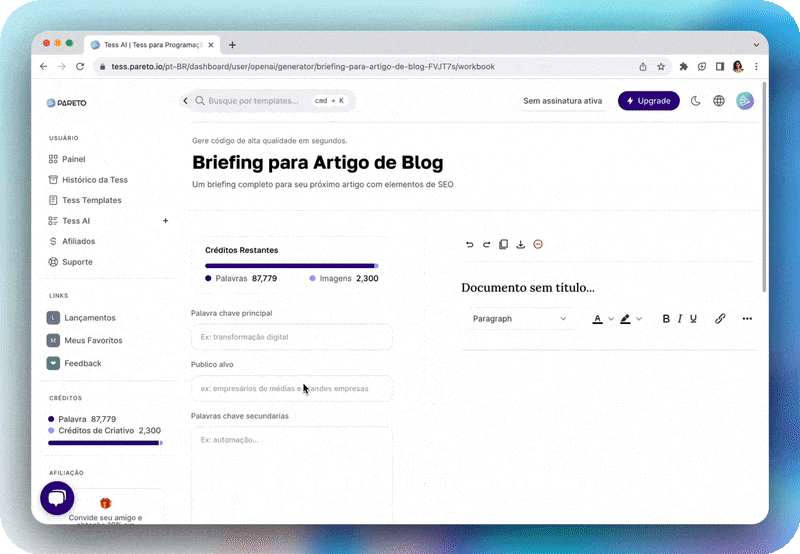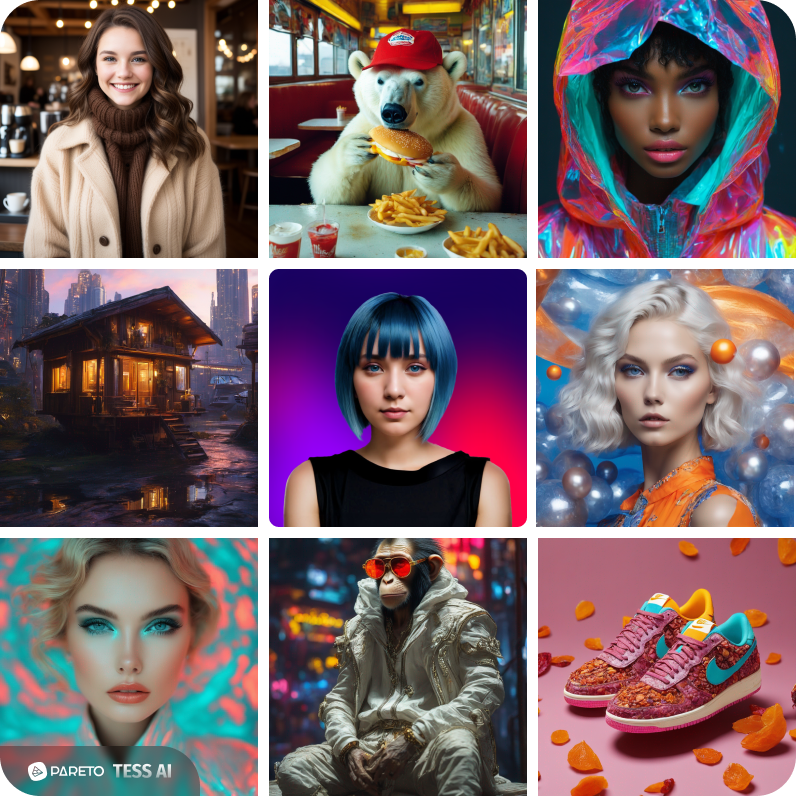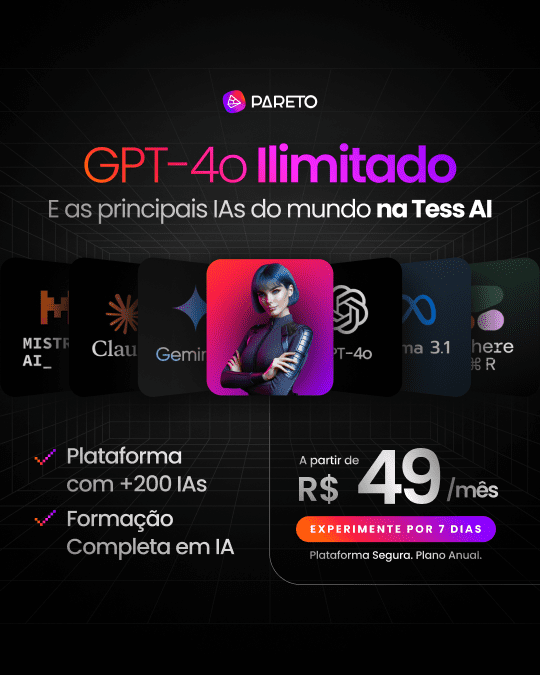The adoption of Generative AI has more than doubled in the last five years, with growing investments and a transformative potential in various sectors. Companies are rapidly incorporating artificial intelligence (AI) into their businesses to tap into a promising market.
Research by McKinsey indicates that these applications could add up to 4.4 billion dollars annually to the global economy, making them essential over the next three years in the technological, media and telecommunications landscape.
Because it's so important, in this article we'll explain in more depth what generative AI is, how it works, its main applications and how it can boost your business. Read on and find out more!
What is Generative AI?
Generative AI uses deep learning models to learn the essence of a data set and, from that understanding, create something new.
Generative AI is a technology that uses advanced machine learning and patterns found in training data to create personalized content.
Some examples of generative AI tools include Tess AI, ChatGPT, Gemini, DALL-E, Stable Diffusion, Llama, Claude, among others.
What is the Origin of Generative AIs?
- Generative AI has been in development since the 1970s, with the aim of generating texts on its own. Engineers specializing in AI eventually began training GANS, generative adversarial networks, capable of producing texts based on human speech
- The rise of modern generative AIs is strongly driven by increased computer processing power and access to large volumes of data, which are essential for training these complex models
- In 2014, a notable breakthrough occurred with the introduction of Adversarial Neural Networks (GANs), an architecture proposed by Ian Goodfellow and colleagues. GANs consist of two components: the generator, which creates data, and the discriminator, which assesses whether the data is authentic or generated
- These components are trained together, improving each other. GANs have revolutionized the creation of generative content, enabling the generation of images, text, audio and other types of data with impressive quality.
- More recently, in 2023, OpenAI launched GPT-4, a significant evolution from previous models. With billions of parameters, GPT-4 offers greater precision, creativity and understanding of complex contexts, allowing for the generation of more diverse and refined textual content.
What's the Difference Between Ordinary AI and Generative AI?
If you have any doubts about the difference between these technologies, the answer is simple. Common AI is a broad field that encompasses technologies designed to mimic human cognitive functions, such as learning, problem-solving and decision-making.
Generative AI, on the other hand, is a specific subcategory of AI that focuses on creating new content from trained models.
Using advanced neural networks, Generative AI learns the essence of the training data and applies this knowledge to generate original and creative results.
What Are the Types of Generative AI?
Generative AI opens doors to a diverse range of creative and practical applications. Let's explore some of the areas in which generative AI is shaping today's landscape.
Generative AI for Text Generation
Generative AI can create cohesive and relevant texts in a variety of styles and topics, making it a valuable tool for professionals in a variety of fields.
Get to know Tess AI of Pareto, the first AI orchestrator in Brazil. It connects to the world's leading AIs, allowing you to easily create text, images, videos and much more. Just provide a topic or idea, and the AI will take care of everything in seconds. See below for an example of text generation:
Generative AI for Image Generation
AI image generation uses trained models to convert text descriptions into visual representations.
You can generate anything from abstract illustrations to realistic images. With this technology, you can customize aspects such as style, color, dimensions, among other parameters
Here's a preview of the realistic images generated by Tess AI.

For more inspiration, go to 50 Prompts for Creating Amazing Images with Tess AI and discover how to improve your imaging ideas with AI.
Generative AI for Video Generation
Generative AI for video generation is a tool for creating personalized content, meeting the individual needs of viewers or customers. This can be applied to personalized tutorials, targeted ads and tailor-made learning experiences.
By combining visual elements, generative AI can create engaging videos and animations for use in entertainment, advertising, education, etc. Just add commands presenting your idea in text and/or a reference image, and in a few minutes, the video is generated automatically.
Generative AI for Code Generation
Generative AI plays a crucial role in facilitating the creation of codes and algorithms, making the software development process more efficient and agile.
In addition, it is capable of improving existing code, identifying points that can be improved in algorithms and offering suggestions for increasing the efficiency and performance of programs. It also saves time and resources for developers and engineering teams.
Text to Audio Transcription
Text-to-speech transcription is an AI technology that transforms the creation and use of synthetic voices, producing highly realistic and natural voices.
For professionals in content production, digital marketing, dubbing and other areas that need audio, this technology is essential. It is ideal for promotional videos, social networks, audiobooks, podcasts, virtual assistants, chatbots and other applications.
Here's an example of text-to-speech transcription using the ElevenLabs tool in Tess AI.
Generative AI for Language Translation
Generative AI for language translation doesn't just convert words, it adapts style and tone to make the translation sound more natural.
In other words, it understands context and culture, allowing translations that respect cultural nuances and idiomatic expressions. This results in more accurate and contextual translations, promoting effective and authentic global communication.
In addition, its scalability makes it a versatile tool, meeting the growing demands of global translation.
What are the Challenges of Generative AI?
Generative AI is constantly evolving, but it faces several challenges on its development journey. These are some of the main obstacles to be overcome:
1. computing infrastructure
Generative AI requires robust computing resources, including powerful hardware to train and run complex models. Training requires high-performance server clusters and advanced GPUs, which can generate high costs.
In addition, the rapid evolution of technology requires frequent updates to the infrastructure to keep it optimized.
2. Sampling speed
Generative models can generate samples slowly, especially advanced ones. Improving speed requires developing more efficient algorithms and optimizing hardware.
This aspect is crucial in real-time applications such as games, simulations and virtual assistants, making it essential to overcome this challenge in order to make the most of Generative AI.
3. Data Quality
Generative models need large volumes of high-quality data to create meaningful content. Accurate and representative data, free from bias, is essential to avoid problematic results.
The challenge includes collecting, curating and cleaning the data to ensure its accuracy. In addition, the quality of the data affects the interpretation of the results generated, especially in complex models such as deep neural networks.
4. Data licenses
Gaining access to data and managing usage licenses are significant challenges in Generative AI. This includes data collection, which can be limited by copyright and other legal restrictions, and the use of pre-trained models with license restrictions.
As research into Generative AI advances, overcoming these challenges is essential to unlocking the full potential of these technologies and making them more accessible and effective in a variety of practical applications.
What Are the Benefits of Generative AI?
Generative AI offers a number of benefits. We've listed some of the main ones:
1. Creating Authentic Content
Generative AI can create original and compelling content comparable to that produced by humans, offering efficiency by automating processes and saving time and resources in sectors such as marketing and entertainment.
In addition, scalability allows companies to expand their content production and reach a larger audience, without the need to proportionally increase their teams.
2. Creating Personalized Content
Generative AI can create tailor-made content, such as product recommendations, music, art and even texts, based on individual preferences and needs.
In addition, the ability to generate personalized text is another valuable application. Generative AI can produce written content, such as articles, stories or messages, adapting to the desired style and tone, meeting specific communication needs.
3. Efficient Data Processing
Generative AI improves the efficiency of processing large data sets, enabling faster analysis and the extraction of valuable insights. In scientific research, it speeds up the interpretation of experimental data.
In the financial sector, it is used for real-time market analysis and fraud detection. In healthcare, it improves the analysis of medical images and diagnostic accuracy, contributing to faster and more accurate diagnoses.
4. Improved User Experience
Generative AI has the ability to personalize user interaction, adapting content and services according to individual preferences, making the experience more relevant and engaging.
For example, on streaming platforms such as Netflix, AI is used to analyze a user's viewing history and preferences. Based on this data, it can generate highly personalized recommendations, suggesting films and series that are more likely to attract the viewer's interest.
5. Saving Time
The automation of repetitive tasks such as content creation, data analysis and even text writing can be facially automated with Generative AI, contributing to greater efficiency in different sectors.
This is undoubtedly a valuable tool for saving time and resources, allowing people and organizations to focus on more productive and creative activities.
6. Security Enhancement
Security enhancement is yet another crucial benefit provided by generative AI. Especially in the field of cyber security, generative AI plays a key role in identifying and mitigating threats.
For example, in the generation of complex passwords and encryption keys, making it more difficult for attackers to access protected systems.
How does Generative AI work?
Training a generative AI is essential for the machine to create original and authentic content. Various techniques and models have been developed to achieve remarkable results in different areas. Explore some of the main training techniques below!
- Large Language Model (LLM): Large Language Models are trained on huge volumes of text to learn the complexities of human language.
- Generative Adversarial Networks (GAN): GANs are an innovative architecture made up of two components: the generator and the discriminator. The generator creates data, while the discriminator assesses whether this data is authentic or generated.
- Transformer-based templates: Transformer-based models, such as GPT, have revolutionized text generation. They use an architecture that captures word relationships in long contexts.
- Variational Autoencoder Models (VAEs): VAEs are mainly used in image generation. They seek to learn the latent representation of a data set, allowing new images to be generated by manipulating this latent representation in a controlled manner.
Application of Generative AIs in Everyday Life
To make all the knowledge about AI more understandable, let's take a look at the applications of this technology in everyday life.
Marketing and Advertising
Generative AI simplifies the rapid creation of content on a large scale, playing a vital role in marketing. Companies and professionals turn to these tools to generate images, captions, product descriptions, branding materials and blog posts, among others.
It also allows you to personalize ads and create captivating content efficiently, turning challenges into strategic opportunities.
Art and Design
Generative AIs are playing a transformative role in art and design. They empower not only artists and designers, but also enthusiasts who want to create art, be it abstract, realistic, watercolor, etc.
This practicality also simplifies the graphic and product design process, making it possible to efficiently generate three-dimensional models of objects and environments. Check out Tess AI's illustration of a sofa set below.
Accessibility
Generative AI makes technology more inclusive for people with disabilities. Its main benefits include:
- Speech-to-text conversion: transcribes speech into text, facilitating communication for hearing-impaired people.
- Generating Audio from Text: converts text into audio, helping visually impaired people access online information and documents.
- Assistive Technologies: allows control of devices through voice commands, gestures or thoughts for people with physical disabilities.
- Web and App Accessibility: improves the usability of websites and apps, offering adaptations such as font enlargement and voice navigation.
- Augmentative and Alternative Communication (AAC): a ids the expression of thoughts and ideas through symbols, images or computer-generated voice.
Games
The integration of Generative AIs into games has significantly transformed the player experience. Here's why:
- Procedural Content Generation: generative AIs are used to create game environments procedurally, generating dynamic and unique scenarios. This makes gaming experiences more varied and engaging;
- Intelligent Character Behavior: non-playable characters (NPCs) now have more realistic and adaptable behaviors, responding authentically to players' actions, which increases immersion;
- Interactive Dialogues and Dynamic Narratives: Generative AIs enable interactive dialogues and narratives, allowing players to influence the development of the story, making the experience more personalized and captivating;
- Advanced Graphics and Special Effects: AI is used to create more impressive graphics and visual effects, providing a high-quality visual experience in games;
- Game Development and Testing: AIs are also used to speed up the game development and testing process, automating repetitive tasks and identifying bugs.
Internet browsing
Microsoft and other companies in the sector are increasingly adopting generative AI models to offer more personalized experiences when searching the Internet. One approach involves expanding the query by creating relevant keywords to refine searches.
This means that instead of simply receiving a list of search links, these new and improved models can use generative AI to provide natural language search results, such as quick and direct answers.
How will Generative AI affect industries?
Technology is expected to impact different areas. Some possibilities in the segments mentioned are:
- Entertainment: generative AI revolutionizes the creation of creative content, including scripts, music and works of art. It improves visual effects and animations in films and games, providing more engaging and personalized experiences for audiences.
- Finance: in the financial area, generative AI processes large volumes of data in real time to identify trends and predict market movements. It also automates reporting and trading, improving accuracy and efficiency.
- Education: technology enables the creation of personalized teaching materials, adapting learning resources and assessments to the needs of each student. It also facilitates the production of educational lessons and videos, speeding up the availability of quality content.
- Agriculture: generative AI analyzes data on soil, climate and crop history to offer personalized recommendations to farmers. It also uses satellite images and drones to monitor crop growth and optimize irrigation, improving water management.
To see the full list, go to 17 Examples of Artificial Intelligence in Your Daily Life.
Conclusion
Generative AI demonstrates its versatility by empowering systems to generate content in various forms, radically transforming the way you interact with technology and create different types of content.
As technology advances, new applications are expected to emerge, further driving innovation in a wide range of sectors. You don't want to be left out of this technological transformation, do you?
Try Tess AI for 7 days with a satisfaction guarantee or get your money back! Boost your business now.





